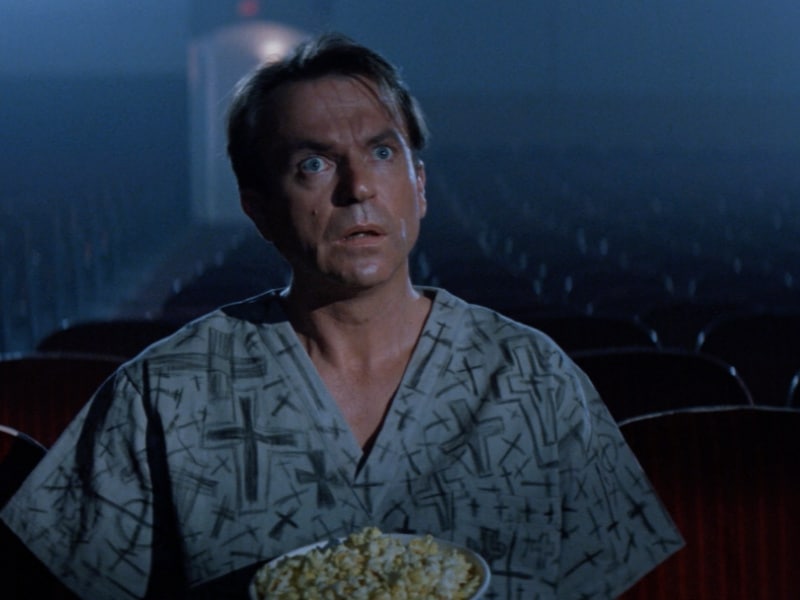
It’s John Carpenter’s birthday this week, so of course we gave a listen to one of the few commentary tracks he’s done that we haven’t covered yet. (And now we know why.)
In the Mouth of Madness (1994)
Commentator: John Carpenter (director), Gary B. Kibbe (cinematographer)
1. Carpenter himself refers to this as the third film in his unofficial “Apocalypse Trilogy” which also includes The Thing and Prince of Darkness.
2. The opening credits sequence was filmed by the second-unit at a printing press in Toronto, Canada.
3. The asylum exterior/main hall is actually a water reclamation plant off Lake Ontario, while the basement cells were built on a set.
4. Sam Neill, who plays John Trent, was cut by broken glass in the scene where his cell door window is shattered. “He wasn’t too happy about it.”
5. Neill is apparently “the world’s biggest fan of The Beach Boys.
6. The guy with the ax who attacks Trent at the restaurant is wearing contact lenses courtesy of KNB EFX. “He was a real trooper, I think he scratched his cornea.”
7. Carpenter says the scene where Trent wakes from a dream only to then actually wake from the dream is “an old horror trick I first used in Prince of Darkness. It worked better there because the monster was a little scarier, but this one works all right.”
8. Kibbe explains his lighting choices at one point, and Carpenter says all of his complicated terminology is why he avoided photography at film school and compares it to trying to learn calculus. “It’s much easier to be a director than it is to light a set.”
9. The first three-legged dog they had took off running “across the countryside” and had to be chased down, but it wasn’t found in time for shooting.
10. Carpenter recalls the Pickman Hotel is a home built by a man for his wife, but when she died en route to America he turned it into a shrine of sorts to their love.
11. From around the thirty-minute mark onwards, Neill and Julie Carmen (who plays Linda Styles) are essentially in the same wardrobe. “They loved the idea in the beginning and then started bitching about it later,” says Carpenter.
12. “I don’t like working with dogs in scenes where they have to attack.” The Doberman scene resulted in “some pretty serious bites” to the stuntmen causing some hospital visits.
13. The shot of the church out the window at 41:05 has been the subject of questions to both Carpenter and Kibbe asking if it’s a matte painting. It is not. It’s a Russian Orthodox church “in the middle of nowhere.”
14. The overhead shot at 56:11 was suggested by Neill, “who began his career as a director” of documentaries back in New Zealand. He said the film’s editor would be thankful for the shot.
15. Carpenter’s favorite line in the film is “Reality’s not what it used to be.”
16. He refers (jokingly?) to the scene where Trent throws a glass in the bar as “retaliation” for the earlier instance where Neill was cut by the window. “I was sitting in front of him… and a little piece went in my eye.” For his part though Neill promises it wasn’t intentional.
17. The scene where Styles exits the car with her head upside down was shot with a contortionist.
18. They had to shrink the budget from $15 million to $10 million, and one of the big cuts was a third-act sequence that saw the entire town be swallowed up into the book. Writer Michael De Luca instead came up with the idea of the “book paper illusion” that sees Sutter Cane (Jurgen Prochnow) rip himself like a page in a book.
Best in Context-Free Commentary
“Shooting in Panavision once again, my favorite aspect ratio.”
“I hate working in the cold.”
“I hate working long days.”
“Children in movies always love to play monsters. They love it more than anything else. They try to be evil.”
In the Mouth of Madness [Blu-ray]
Final Thoughts
Well, the movie still rocks anyway even if the commentary does not. It’s very technical in nature, to the point of tedium at times, as Carpenter focuses on camera lens details, locations, and plot while constantly asking Kibbe to explain his lighting decisions. A few anecdotes slip though, but it’s again clear that Carpenter’s at his best on commentaries when he has an actor there supporting him. They’re naturally more charismatic and engaging in their chatter whereas Kibbe’s only here to answer tech questions. A lot of tech questions.
Read more Commentary Commentary from the archives.
Related Topics: Commentary Commentary, Filmmaking, Home Video, John Carpenter
